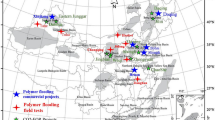When a reservoir is subjected to long-term water and polymer flooding, the formed preferential flow paths are widely distributed in the formation, and the displacing fluid effect is reduced, thus leaving a large amount of remaining oil unexploited. To enhance the oil recovery efficiency after polymer flooding, it is important to provide effective methods to block the preferential flow paths. The statistical data analysis results of 20 wells after polymer flooding in the Daqing oilfield show that the remaining oil and the preferential flow paths are mainly distributed vertically in the sedimentation units named PI2 and PI3, and the physical plugging and traditional adjusting techniques are not effective. Considering the above, an adaptive compound flooding method is put forward, which is based on the idea of “plugging, adjusting, and flooding. Laboratory experiment results show that the enhanced oil recovery (EOR) of the new polymer flooding method is 13.6%, which is 4.9% higher than that of alkaline/surfactant/polymer (ASP) flooding. The polymer consumption of the new method is more than 10% lower than that of conventional polymer flooding.




Similar content being viewed by others
References
E. J. Manrique, C. P. Thomas, R. Ravikiran, M. I. Kamouei, M. Lantz, J. L. Romero, et. al., “EOR: current status and opportunities,” in: SPE-130113-MS, SPE Improved Oil Recovery Symposium, Tulsa, Oklahoma, USA, 24–28 (2010).
P. Daripa and G. Pasa, “An optimal viscosity profile in enhanced oil recovery by polymer flooding,” Int. J. Eng. Sci, 42(19-20), 2029-2039 (2004).
J. A. Vargas-Guzman, A. Al-Gaoud, A. Datta-Gupta, et. al., “Identification of high-permeability zones from dynamic data using streamline simulation and inverse modeling of geology,” J. Pet. Sci. Eng., 69(3-4), 283-291 (2009).
D. Lin, Y. Shi, L. Xuan, Y. Wang, and X. Li, “In-depth profile control and carbon dioxide huff-puff in the late stage of ultra-high water-cut oil reservoir development,” Spec. Oil Gas Reserv., 25(2), 65-69 (2018).
P. Xia, J. Wu, S. Wu, and Y. Li, “Research and application of a new type of particle profile control agent and profile control,” J. Petrochem. Univ., 30(4), 23-26 (2017).
X. Zhao, Y. Gao, and L. Wu, “Experimental study on high temperature resistant and high strength water shut-off agents,” Oil Gas Field Surf. Eng., 29(3), 24-25 (2010).
M. Navratil, “Compositions and methods for reducing the permeability of underground strata,” Patent US 4663367. 1987-5.5 (1987).
B. L. Hunter, R. S. Buell, and T. A. Abate, “Application of a polymer gel system to control steam breakthrough and channeling,” SPE Western Regional Meeting, Bakersfield, California, USA, SPE-24031-MS (1992).
Y. Feng, R. Tabary, et. al., “Characteristics of microgels designed for water shutoff and profile control,” SPE International Symposium of Oilfield Chemistry, Houston, Texas, USA, SPE-802030-MS (2003).
J. P. Heller, “CO2 foams in enhanced oil recovery,” Adv. Chem., 242, 201–209 (1994).
K. Ma, J. L. Lopez-Salinas, M. C. Puerto, C. A. Miller, S. L. Biswal, and G. J. Hirasaki, “Estimation of parameters for the simulation of foam flow through porous media. Part 1: the dry-out effect,” Energy Fuels, 27(5), 2363-2375 (2013).
G. F. Li, R. J. Hirasaki, C. A. Miller, and S. R. Masabneh, “Wettability alteration and foam mobility control in a layered 2-heterogeneous sandpack,” SPE J., 15, 928-942, SPE-141462-MS (2011).
W. Cao, T. Dai, J. Yu, T. Lu, A. Cheng, and K. Xi, “A numerical simulation method of heterogeneous combination flooding,” Oil Gas Geol., 37(4), 606-611 (2016).
Acknowledgments
This work has been financially supported by China National Petroleum Corporation (No. 2011ZX05010).
Author information
Authors and Affiliations
Corresponding author
Additional information
Translated from Khimiya i Tekhnologiya Topliv i Masel, No. 2, pp. 87 – 91, March – April, 2021.
Rights and permissions
About this article
Cite this article
Gao, Q., Zhong, C., Han, P. et al. Characteristics of Preferential Flow Paths in Reservoirs After Polymer Flooding and an Adaptive Compound Flooding Method. Chem Technol Fuels Oils 57, 368–375 (2021). https://doi.org/10.1007/s10553-021-01255-6
Published:
Issue Date:
DOI: https://doi.org/10.1007/s10553-021-01255-6



